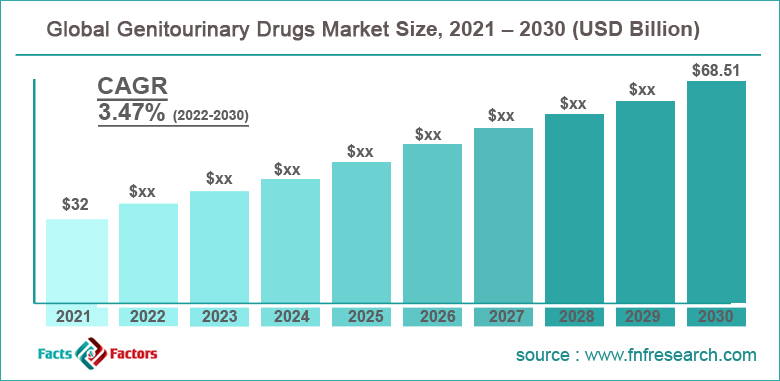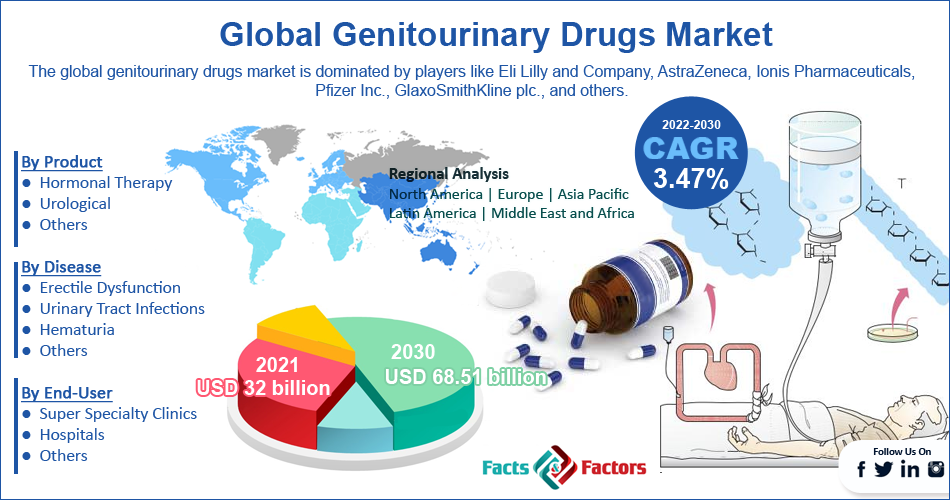Search Market Research Report
Genitourinary Drugs Market Size, Share Global Analysis Report, 2022–2030

Genitourinary Drugs Market Size, Share, Growth Analysis Report By Product (Hormonal Therapy, Urological, and Others), By Disease (Erectile Dysfunction, Urinary Tract Infections, Hematuria, and Others), By End-User (Super Specialty Clinics, Hospitals, and Others), and By Region - Global and Regional Industry Insights, Overview, Comprehensive Analysis, Trends, Statistical Research, Market Intelligence, Historical Data and Forecast 2022–2030
Industry Insights
[216+ Pages Report] According to the report published by Facts Factors, the global genitourinary drugs market size was worth around USD 32 billion in 2021 and is predicted to grow to around USD 68.51 billion by 2030 with a compound annual growth rate (CAGR) of roughly 3.47% between 2022 and 2030. The report analyzes the global genitourinary drugs market drivers, restraints/challenges, and the effect they have on the demands during the projection period. In addition, the report explores emerging opportunities in the genitourinary drugs market.

 Market Overview
Market Overview
The genitourinary system, also known as the urogenital system, consists of organs related to the urinary and reproductive systems. Organs corresponding to these systems are grouped since they are close to each other in the human body. Other factors like the utilization of common pathways and the same embryological origin also lead to the organs being imaged together. Genitourinary drugs are used for the treatment of medical concerns associated with reproductive or urinary organs. There are different types of diseases associated with these systems and sometimes may differ from the conditions that show symptoms or an array of signs.
The main causes of these disorders may range from infectious diseases, congenital anomalies, or in some cases may involve urinary structure. Genitourinary drugs fall under the segment of genitourinary pathology which in itself is a sub-segment of surgical pathology that is related to the treatment diagnosis and treatment of non-neoplastic and neoplastic diseases found in the male genital tract, urinary tract, and testicles. Genitourinary pathologists are known to work closely with urologic surgeons. Genitourinary medicines include doses for relieving bladder spasms, treating erectile dysfunction, and urinary pH, and medicines to suppress preterm labor.
 Key Insights
Key Insights
- As per the analysis shared by our research analyst, the global genitourinary drugs market is estimated to grow annually at a CAGR of around 3.47% over the forecast period (2022-2030)
- In terms of revenue, the global genitourinary drugs market size was valued at around USD 32 billion in 2021 and is projected to reach USD 68.51 billion, by 2030.
- The market is projected to grow at a significant rate due to the growing investments in research & development in the healthcare field
- Based on product segmentation, hormonal therapy was predicted to show maximum market share in the year 2021
- Based on end-user segmentation, hospitals were the leading end-users in 2021
- On the basis of region, North America was the leading revenue generator in 2021

 Growth Drivers
Growth Drivers
- Growing cases of ovarian and prostate cancer to drive market demand
The global genitourinary drugs market is projected to grow owing to the increasing cases of prostate and ovarian cancer. The former occurs in the gland cells found in the prostate of the male reproductive system where ovarian cancer starts in the ovaries, the female reproductive system. Although these cancer types have been in existence for many decades, owing to the increasing awareness amongst the population, more people are likely to invest in the treatment of the diseases. The American Cancer Society has estimated that more than 19,880 women will be diagnosed with ovarian cancer by the end of 2022 while 12810 women are estimated to succumb due to the disease. It currently ranks fifth position in the list of cancer-related deaths in women. The lifetime ratio of a woman dying due to ovarian cancer is known to be 1:108.
Prostate cancer is considered the most common type of cancer among men following skin cancer. As per estimates, 1 in every 8 men may be diagnosed with prostate cancer during his lifetime. It is known to develop in older men and non-Hispanic black men. More than 6 out of 10 cases diagnosed in men are found in men above 65 years of age.
 Restraints
Restraints
- Increasing expiration rate of patents to restrict market expansion
The global market growth is anticipated to witness restriction during its growth trajectory owing to the growing patent expiration of medicines. This means that once the patents have expired, the medicine can be manufactured by local producers and the original company does not have specific rights for the production of the drugs. Such incidents mean heavy losses for the pharmaceutical giants who have invested multiple resources in the research and development of the product. Patent loss leads to the onset of the patent cliff during which the companies register heavy losses as they lose the sole right to produce the drug.
 Opportunities
Opportunities
- Growing number of reproduction-related medical assistance to provide growth opportunities
The global genitourinary drugs market is anticipated to benefit from the growing number of reproduction-related medical assistance undertaken by the population. Across the globe, a large section of people is witnessing challenges in reproducing naturally due to various reasons including hormonal imbalance and infertility amongst other causes. This has resulted in people seeking professional medical help to aid reproduction. The methods may include in-vitro fertilization (IVF), surrogacy, or treatment for infertility to name a few. As of a May 2019 report, more than 8 million babies were born through IVF and the number is still growing.
 Challenges
Challenges
- Presence of counterfeit products to challenge market growth
One of the major challenges the global market players face is the presence of various low-grade or counterfeit drugs in the market sold at the same price as original medicines. However, counterfeit drugs are ineffective in treating a medical condition and lead to severe consequences turning fatal in many situations. Hence government regulatory agencies need to invest higher resources in tracking the manufacturers and suppliers of low-grade products to help patients get access to the right medicine.
 Segmentation Analysis
Segmentation Analysis
The global genitourinary drugs market is segmented based on product, disease, end-user, and region
Based on product, the global market divisions are hormonal therapy, urological, and others. The global market witnessed the highest returns in the hormonal therapy segment owing to the increasing cases of hormonal imbalance among women and men leading to difficulties in natural reproduction.
As the awareness and accessibility to fertility clinics have grown multifold in the last few years, the demand for the right hormonal medical care has witnessed an unprecedented rise. Multiple factors can cause hormonal imbalance including lifestyle, eating habits, prior health concerns, and stress to name a few. Multiple reports have pointed out that more than 80% of women suffer from hormonal imbalances.
Based on end-user, the global market divisions are super specialty clinics, hospitals, and others. Although doctors generally recommend critical cases to specialty clinics because they have more expertise, the hospital segment dominated the global market growth in 2021. Hospitals are responsible for providing primary care and only if the case is extremely rare, the cases are moved to specialty units. Urinary tract infection is known to affect nearly 3% of the global men population.
 Recent Developments:
Recent Developments:
- In October 2022, Pfizer, a leading pharmaceutical giant, announced the positive results obtained while testing the phase 3 TALAPRO-2 trial of TALZENNA® which is used as an inhibitor for poly ADP-ribose polymerase
- In November 2022, the United States Food and Drugs Administration department approved the abbreviated application of Leuprolide Acetate Injections to be used in advanced cases of prostate cancer
 Report Scope
Report Scope
Report Attribute |
Details |
Market Size in 2021 |
USD 32 Billion |
Projected Market Size in 2030 |
USD 68.51 Billion |
CAGR Growth Rate |
3.47% CAGR |
Base Year |
2021 |
Forecast Years |
2022-2030 |
Key Market Players |
Eli Lilly and Company, AstraZeneca, Ionis Pharmaceuticals, Pfizer Inc., GlaxoSmithKline plc., and others. |
Key Segment |
By Product, Disease, End-User, and Region |
Major Regions Covered |
North America, Europe, Asia Pacific, Latin America, and the Middle East &, Africa |
Purchase Options |
Request customized purchase options to meet your research needs. Explore purchase options |
 Regional Analysis
Regional Analysis
- North America to lead with the highest CAGR
The global genitourinary drugs market is projected to witness the highest growth in North America owing to the robust research and development activities conducted in the pharmaceutical industry of the US and Canada. In 2021, Johnson and Johnson, one of the leading pharmaceutical giants in the world, spent USD 14.75 billion on research activities. The company has been in the healthcare sector for over a decade.
North America is home to some of the biggest brands in the drug development sector. The regional growth may further be driven by the growing awareness about types of cancer-related to the reproductive organs and proactive measures adopted by the regional population to treat the diseases. This is supported by the presence of advanced medical infrastructure along with excellent medical reimbursement policies and high disposable income.
 Competitive Analysis
Competitive Analysis
- EliLillyandCompany
- AstraZeneca
- IonisPharmaceuticals
- PfizerInc.
- GlaxoSmithKlineplc.
The global genitourinary drugs market is segmented as follows:
 By Product Segment Analysis
By Product Segment Analysis
- Hormonal Therapy
- Urological
- Others
 By Disease Segment Analysis
By Disease Segment Analysis
- Erectile Dysfunction
- Urinary Tract Infections
- Hematuria
- Others
 By End-User Segment Analysis
By End-User Segment Analysis
- Super Specialty Clinics
- Hospitals
- Others
 By Regional Segment Analysis
By Regional Segment Analysis
- North America
- The U.S.
- Canada
- Mexico
- Europe
- France
- The UK
- Spain
- Germany
- Italy
- Nordic Countries
- Denmark
- Sweden
- Norway
- Benelux Union
- Belgium
- The Netherlands
- Luxembourg
- Rest of Europe
- Asia Pacific
- China
- Japan
- India
- Australia
- South Korea
- Southeast Asia
- Indonesia
- Thailand
- Malaysia
- Singapore
- Rest of Southeast Asia
- Rest of Asia Pacific
- The Middle East & Africa
- Saudi Arabia
- UAE
- Egypt
- South Africa
- Rest of the Middle East & Africa
- Latin America
- Brazil
- Argentina
- Rest of Latin America
Industry Major Market Players
- EliLillyandCompany
- AstraZeneca
- IonisPharmaceuticals
- PfizerInc.
- GlaxoSmithKlineplc.
Frequently Asked Questions

Copyright © 2024 - 2025, All Rights Reserved, Facts and Factors


